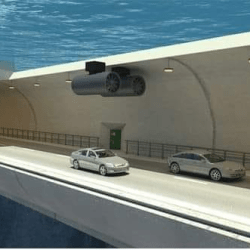Pre-tensioning is a specialized technique employed in modern construction to enhance the strength, durability, and functionality of concrete structures, particularly roads and bridges. As a subset of prestressed concrete technology, pre-tensioning is vital for ensuring these structures can handle heavy loads and maintain long-term stability. Below is an overview of the pre-tensioning process, its benefits, challenges, and significance in infrastructure development.
The Pre-Tensioning Process: Key Steps
- Tensioning Steel Strands
- High-strength steel tendons or strands are stretched along a casting bed to a specific level of tension using hydraulic jacks.
- The strands are anchored securely at both ends to maintain tension throughout the process.
- Pouring Concrete
- With the tendons in tension, concrete is poured over and around them, completely encasing the steel strands.
- The tensioned tendons interact with the concrete during the setting process, ensuring a strong bond.
- Cutting the Tendons
- Once the concrete achieves the required strength, the steel tendons are cut.
- This action releases the tension, transferring compressive forces to the concrete, which strengthens it against tensile stresses.
How Pre-Tensioning Enhances Concrete Structures
Concrete is inherently strong in compression but weak in tension. Pre-tensioning addresses this limitation by:
- Imparting Compressive Stress: Counteracts tensile forces experienced during the structure’s lifecycle, reducing the likelihood of cracking.
- Improving Load Capacity: Allows the structure to bear heavier loads by balancing internal stresses.
- Enhancing Durability: Increases resistance to environmental stressors, ensuring longer service life.
Advantages of Pre-Tensioning
Pre-tensioning offers numerous benefits for infrastructure development:
- Improved Span Efficiency:
- Enables the construction of longer spans with fewer supports, making designs more economical.
- Reduces girder lines and increases girder spacing, streamlining bridge and road construction.
- Reduced Material Requirements:
- Shallower superstructures save material costs without compromising strength.
- High-strength concrete and steel strands minimize bulk.
- Durability and Crack Resistance:
- Compression from pre-tensioning controls cracking caused by tensile forces, extending the lifespan of structures.
- Enhanced Aesthetics and Functionality:
- Longer spans and fewer supports result in sleek, visually appealing designs.
Challenges in Pre-Tensioning
While the technique has transformative benefits, it also poses several challenges:
- Fabrication Complexity:
- Requires precise manufacturing of long and slender girders, often exceeding 100 feet in length.
- Handling and Transportation:
- Long girders are difficult to transport and prone to damage during shipping.
- Erection Difficulties:
- Specialized equipment and techniques are needed to erect pre-tensioned girders safely.
- Cost Implications:
- Initial costs are higher due to the need for high-strength materials and advanced machinery.
These challenges are mitigated through innovations in design optimization, modern construction technology, and collaboration between engineers and contractors.
Applications of Pre-Tensioning
Pre-tensioning is widely used in:
- Bridges:
- Enables longer spans with fewer piers, reducing obstructions in waterways or roadways beneath.
- Highway Construction:
- Provides robust and durable pavement that can withstand heavy traffic loads.
- Railway Infrastructure:
- Supports high-speed rail systems with resilient and crack-resistant tracks.
- Commercial and Residential Projects:
- Used in floor slabs, beams, and precast elements to improve structural efficiency.
Economic and Environmental Impact
Pre-tensioning contributes to sustainable and cost-effective construction:
- Resource Optimization: Fewer materials are required due to efficient load distribution.
- Longevity: Durability reduces maintenance and repair costs over time.
- Reduced Carbon Footprint: Longer service life translates to fewer reconstructions, lowering environmental impact.
Pre-Tensioning vs. Post-Tensioning
Pre-tensioning and post-tensioning are both prestressing methods but differ in execution:
| Feature | Pre-Tensioning | Post-Tensioning |
|---|---|---|
| Execution | Steel strands are tensioned before casting concrete. | Strands are tensioned after concrete sets. |
| Typical Application | Precast elements like girders and slabs. | Cast-in-place structures like bridges. |
| Equipment Needs | Casting beds and hydraulic jacks. | Ducts, anchors, and tensioning equipment. |

Pre-tensioning is an indispensable technique in modern construction, enabling engineers to build structures that are not only stronger and more durable but also more efficient and cost-effective. Its role in infrastructure—particularly in roads and bridges—underscores the advancements in materials science and engineering that continue to shape the built environment.
Through innovation and careful design, pre-tensioning bridges the gap between functionality and aesthetics, paving the way for a more resilient and sustainable future in construction.


















